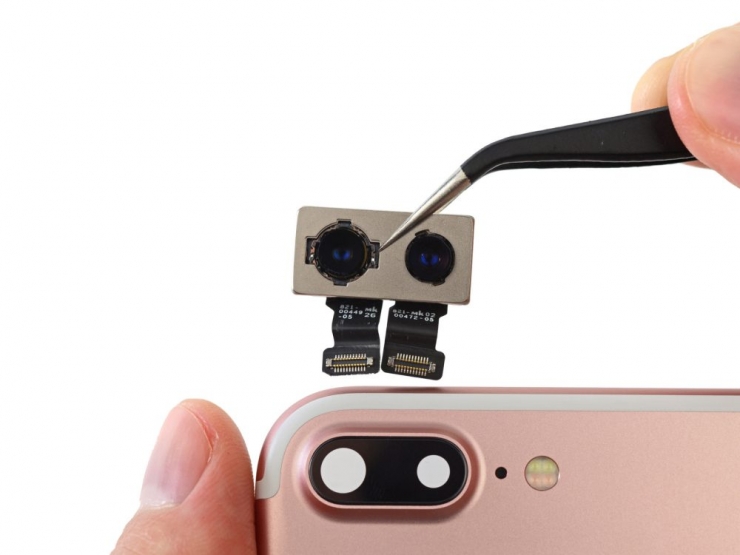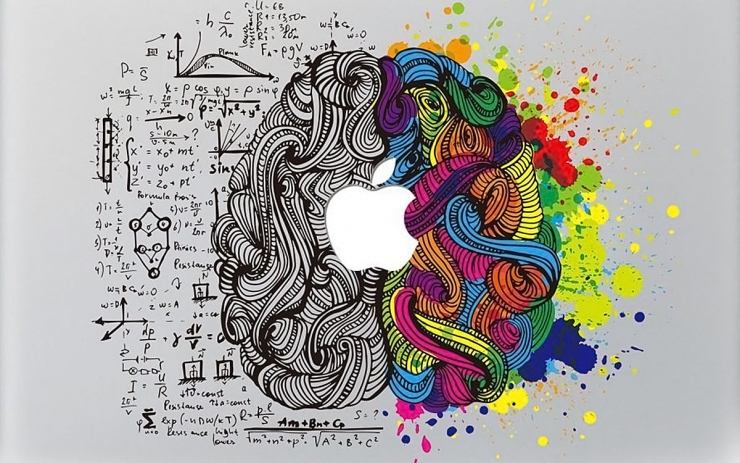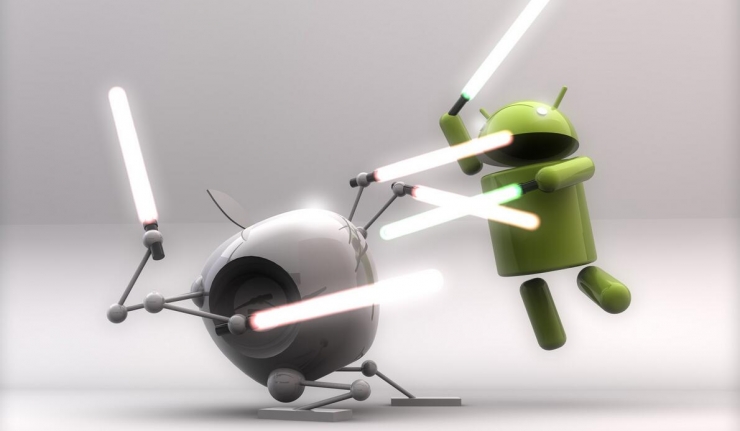
Via: 9to5mac.com
Finally, foreign veterans turned one of the biggest selling points of the iPhone 7 Plus into a double shot.
Unlike many expectations and predictions, the dual cameras of the iPhone 7 Plus don’t seem to be as black on hardware, but they provide a lot of imagination.
2X "optical" zoom achieved with two lensesFrom the information released at the conference, the iPhone 7 Plus has two lenses, one for a wide-angle and one telephoto. When you take a picture, if you choose 2x zoom, it will automatically switch to the telephoto lens.
This description is actually not black technology. On an antique-grade 8mm camera, it is zoomed by rotating the lens to switch the lens.

Via: crystalradio.cn
The iPhone 7 Plus's two lenses, the 135 focal length is 28mm and 54mm respectively, which is almost equal to twice the optical zoom.
In fact, this is an intuitive understanding that everyone will have after reading the conference. But in this case, it seems that Apple did not intend to tell everyone the whole truth.
According to news from the dismantlers, the iPhone 7 Plus's two lenses do not all work independently. When switching to the 2X focal length, it does not necessarily have to work with the 54mm lens .
The tester used one of the easiest ways to try, is to cover two shots separately and see how the iPhone 7 Plus works when shooting. As a result, when covering a 28mm lens, the entire camera is a black screen; however, when a 54mm lens is hidden, it does not affect the camera's operation, including the use of a 2X focal length.
When covering a 54mm lens, the 2X focal length of the iPhone 7 Plus is obviously amplified digitally through the 28mm viewfinder. The principle of digital enlargement is not complicated. When both sides of a digital picture are doubled in size, there will be empty pixels between each pixel. The color of the blank pixels will be calculated by calculating the neighboring pixels. The color value is derived. This results in a digitally magnified photograph.
According to analysts from the dismantlers, the 54-mm lens of the iPhone 7 Plus plays a role in calculating the color of the enlarged fill-in pixels to provide data closer to the real lighting, making the screen clearer and more natural . But when the light is not enough, the lens will not work completely when the amount of light entering the lens is not enough to capture the true color.
This means that the iPhone 7 Plus's dual-camera system, in this version, is still relying on the same 12-megapixel 28mm lens as the iPhone 7. Another 12-megapixel "telephoto" - official website said that telephoto, in fact only standard lens focal length - is just a part-time supporting role.
In addition, it is also through this "laid hand" correction of pixel rendering, making the iPhone 7 Plus has the ability to optical image stabilization .

Via: brunch.co.kr
For this design, foreign disassemblers provided an explanation that it was possible that the amount of light entering the telephoto lens was not satisfactory. In order to achieve the effect of photographs over the previous generation, this expedient was adopted.
Depth of Field Effect "Coming Soon" Apple's Dual Camera Software ReversalIn this release of the iPhone 7 Plus, Apple put a futures satellite on its native features for the first time. In the official website introduction, it is impressively marked with the "coming soon" depth of field effect.

Screenshots from Apple's official website
Obviously, according to the description of the official website, a little understanding will be able to guess the effect of this blurring effect, which comes from the digital rendering of the picture, rather than the “defocus†blur of the optical lens.
What Apple wants to achieve is the effect of this digital rendering and the defocusing effect produced by the optical lens. This is a huge technological breakthrough. And Apple also said in the official website that it will use machine learning technology to challenge this difficult situation.
However, this feature was not yet available when the iPhone 7 Plus was launched. Obviously, the effect of the actual operation may not be satisfactory.
In the history of Apple, this is not the first time that a software feature has not been released yet (remember the hello world presented by the demo software). However, this is the first time that after the start of the sale, it has been openly admitted that a feature is still in development.
In fact, this perfect process is inseparable from the 54mm lens.
The best way to speed up machine learning is to have enough expert system and training data to perform repeated recognition training and optimization.
Maybe the current version of the iPhone 7 Plus can't really make this 54mm lens really play a role in shooting. But in every photo taken by the iPhone 7 Plus, this training program is in progress -
The two cameras mean that the distance and perspective relationship of the picture object can be recognized by the angle difference, and the response of different colors under different light amounts. This data is not fully recorded in the photographs taken, but with the increase in the number of photos taken by the iPhone 7 Plus, this training will accelerate the artificial intelligence capabilities of the Apple dual-camera system.
No one would suspect that Apple will open this "depth of field effect" feature to iPhone 7 Plus users at the latest by the beginning of next year. This does not seem to be an insurmountable obstacle to Apple.
But what actually deserves more attention is what Apple will do after training for this machine learning program, after the "depth of field effect."
iPhone is still the best AI carrier in the world iPhone 7s Plus is worth the waitThe iPhone 7 Plus' 54mm camera, comparable to the iPhone 4's three-axis gyroscope, will open the era of AI applications.
The iPhone 4's three-axis gyroscope made iOS break out of the game as a breakthrough point. The general public has discovered that on smart phones, you can play fresh things far beyond the traditional console or PC gaming experience. This kind of enthusiasm has also attracted countless iOS developers.
This 54mm camera can do more things, but the broad road for developers has not yet opened.
Apple's dual-camera system, if equipped with appropriate software, can theoretically be used to have the ability to recognize real-world object shapes, locations, colors, text, and even dynamic information as human eyes do. This ability to use as a "background blur" is a killer knife. However, the meal should be eaten swiftly. Obviously, at the current stage, Apple officials haven’t even done the “begmatization†perfectly, let alone open up to iOS developers.
This ability, through the training and optimization of AI techniques such as machine learning, will soon reach a relatively high level. Although Apple is not a leader in the field of machine vision, Apple's consistent urine is likely to be a precursor to the commercialization of consumer-grade machine vision.
Whether it is an upstream pure algorithm research and development institution or an application company in the midstream, it cannot ignore the broad market of the iPhone terminal platform. What Apple needs to do is provide enough hardware and middleware to these developers and customers.

Via: flipboard.com
Imagine what will happen when the Apple dual-camera system matures in the underlying information acquisition and identification of machine vision.
1, AR game. Most consumers' perceptions of AR may remain in the sweeping picture. A penguin jumps out and relays the torch. From the identification of two-dimensional codes to the identification of specific pictures is undoubtedly a huge step forward, but the AR that is out of reality is basically a video. But when Apple has the ability to tell you what the camera is "what, how far, in front of something and behind something," game developers may hide a weapon under a table in your camera. You used to deal with monsters that are about to jump in from behind your window...
2, electricity supplier. Similarly, when Apple itself provides the basic information for image recognition, this information can be passed through a third-party machine vision platform and then transferred to the corresponding e-commerce platform. These interfaces and information providers can immediately tell you in the picture what is in the lens, how can it be sold, how much money, and how many friends you have...
3. More creative social media content, and social networking itself. Like the rise of various pictures and social applications in the single-lens era, dual-cameras with AI capabilities are bound to bring new media content and social forms.
In fact, it's impossible to imagine how the double shot will change the picture socialization - we just know that change will happen.
Of course, the current version of the iPhone 7 Plus's dual-camera system is designed to be essentially indistinguishable from LG and HTC's "glue dual camera" design. However, the cruel fact is that due to the change in camera technology and the revolution in camera-related applications, it will definitely happen on Apple's platform. This has little to do with LG or HTC.
The technology foundation for these applications has been developed, and what is missing is the platform interface that is at stake, and the size of the market that can provide sufficient returns—this happens to be Apple's strength.
In August of this year, Cooke said in an interview with The Washington Post: "I think AR technology is quite interesting. It is definitely a core technology." In recent days, Cooke mentioned in an interview with ABC News that AR With stronger social attributes, Apple is confident in the AR's future and will continue to invest in AR.

Via: google.com
It seems that this day will not be too far away.
Therefore, the conclusion is very simple. iPhone 7 Plus is an aggressive attempt by Apple to land for AI applications - whether it is radical to "deepening the field effect" or whether a laboratory application is officially launched on the market. However, this radical move has a huge stimulus to the developer's ecology. One year later, at the level of both mobile Internet applications and AI applications, there is a huge opportunity for market changes.
So, iPhone 7s Plus should be a mature, well-developed, once again amazing mobile phone software. Maybe the way to solve the problem of the yield rate of the bright black craft has solved more ceramic color models.
Coincidentally, from the start of 2015 until now, the investment in AI projects in full swing, and by mid-2017, the time has come for the first wave of wheat harvest to withdraw.
So my prediction is that the iPhone 7s Plus will be a landmark mobile phone that may surpass the iPhone 4 . The era of the official consumerization of the AI ​​industry and the standardization of the next-generation Internet technology will take the lead in launching the 11th-generation iPhone, which will be released in September next year.
Again and:
Intel’s vigorous RealSense Developers movement, which was established last year, is a global convening event to develop middleware and application developers on Android systems based on the X86 architecture, supporting and accelerating their launch of industry-oriented applications. The product or program as a seed developer for RealSense. This batch of developers will pave the way for Intel's machine vision technology to land on consumers and even create the next ASUS or Dell.
There is not much time left for Intel. What's interesting is that in the soon-to-commence commercial competition of AI, iOS is still playing Android. Where is the next-generation system?

Via: bilder.4ever.eu
The handheld addresser is used to program the address of the monitoring module offline. When in use, connect the two output wires of the handheld encoder to the communication bus terminal (terminal label 1, 2) of the monitoring module, turn on the black power switch on the right side upwards, and press "ten Add", [Subtract ten", [Add one place" and [Subtract one place" to program the address.
Motion Sensor Photocell Light Control,Sensor For Motion Control,Exterior Motion Sensor Control,Hollow Shaft Encoder
Changchun Guangxing Sensing Technology Co.LTD , https://www.gx-encoder.com
